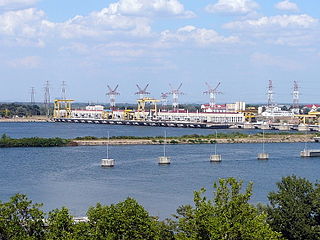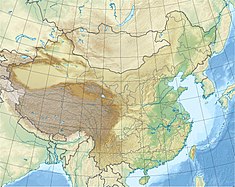
The Three Gorges Dam is a hydroelectric gravity dam that spans the Yangtze River by the town of Sandouping, in Yiling District, Yichang, Hubei province, central China, downstream of the Three Gorges. The Three Gorges Dam has been the world's largest power station in terms of installed capacity (22,500 MW) since 2012. The dam generates an average 95±20 TWh of electricity per year, depending on annual amount of precipitation in the river basin. After the extensive monsoon rainfalls of 2020, the dam's annual production nearly reached 112 TWh, breaking the previous world record of ~103 TWh set by Itaipu Dam in 2016.

The Zhi Qu (Tibetan) or Tongtian River, is a 1,012 km (629 mi) long, flows within Qinghai Province of northwest China. It is begins at the confluence of Tuotuo River and Dangqu River, it flows towards southeast and becomes a Jinsha River near the border of Qinghai and Sichuan. It is within the Yangtze River Basin—Chang Jiang drainage basin.

The Xiluodu Dam is an arch dam on the Jinsha River, i.e. the upper course of the Yangtze in China. It is located near the town of Xiluodu in Yongshan County of Yunnan Province but the dam straddles into Leibo County of Sichuan Province on the opposite side of the river. The primary purpose of the dam is hydroelectric power generation and its power station has an installed capacity of 13,860 MW. Additionally, the dam provides for flood control, silt control and its regulated water releases are intended to improve navigation downstream. Construction on the dam and power station began in 2005 and the first generator was commissioned in 2013, the last in 2014. It is operated by China Yangtze Power and is currently the third-largest power station with the fourth-tallest dam in the world.

The Iron Gate II is a large dam on the Danube River, between Romania and Serbia.

The Wu River is the largest southern tributary of the Yangtze River. Nearly its entire length of 1,150 kilometres (710 mi) runs within the isolated, mountainous and ethnically diverse province of Guizhou. The river takes drainage from a 80,300-square-kilometre (31,000 sq mi) watershed.

The Zangmu Dam (藏木) is a gravity dam on the Yarlung Zangbo/Brahmaputra River 9 km (5.6 mi) northwest of Gyaca in the Tibet Autonomous Region of China. This dam is built a few kilometers from the Bhutan-India border. The purpose of the dam is hydroelectric power production using run-of-the-river technology. It is part of the Zangmu Hydropower Project and supports a 510 MW power station. Construction began in 2009 and the first generator was commissioned in November 2014. The last became operational on 13 October 2015. It is the first dam on the Brahmaputra/Yarlung Zangbo River and has caused controversy in India.

The Shuangjiangkou Dam, also referred to as Shuang Jiang Kou, is an embankment dam currently being constructed in a gorge on the Dadu River in Sichuan Province, China. When completed, the 312 m-tall (1,024 ft) dam will be the tallest dam in the world. Preliminary construction began in 2008 and the entire project was expected to be complete in 2018. By April 2011, over 200,000,000 m3 (261,590,124 cu yd) of material had been excavated from the construction site. In March 2013, China's Ministry of Environmental Protection approved construction on the dam's superstructure and associated facilities. The government acknowledged that the dam would have negative impacts on the environment but that developers were working to mitigate them. The dam is being built by the Guodian Group at a cost of US$4.02 billion. The entire construction period is expected to last 10 years. All turbines are expected to be commissioned by 2023.

The Jiangpinghe Dam is a concrete face rock-fill embankment dam on the Loushui River near Jiangpinghe village, Zouma Town, in Hefeng County in Hubei Province, China. The purpose of the dam is hydroelectric power generation, flood control and irrigation. The dam houses a hydroelectric power station with 2 x 250 MW generators for a total installed capacity of 500 MW. Its expected generation of 1005 GWh will be transferred to the Central China Power Grid. Construction on the dam began in 2005 and the first generator went online in July 2012. The dam is 221 metres (725 ft) tall, withholding a 1,366,000,000 cubic metres (1,107,434 acre⋅ft) reservoir of which 787,000,000 cubic metres (638,031 acre⋅ft) is active or "useful" storage.

The Liyuan Dam is a concrete-face rock-fill dam on the Jinsha River on the border of Yulong County and Shangri-La County, Yunnan Province, China. The dam has an associated hydroelectric power station with a 2,400 MW power station containing 4 x 600 MW generators. Construction on the river diversion for the dam began in 2008. It began to impound its reservoir in November 2014 and on December 28, 2014 the first generator was commissioned. The second generator was commissioned in July 2015.

The Silin Dam is a concrete gravity dam on the Wu River in Sinan County, Guizhou Province, China. The dam has an associated hydroelectric power plant with a 1,080 MW capacity utilizing 4 x 270 MW Francis turbine-generators. The dam is 310 m (1,017 ft) long, 117 m (384 ft) high and composed of roller-compacted concrete. Its reservoir has a 1,205,000,000 m3 (976,909 acre⋅ft) capacity, 184,000,000 m3 (149,171 acre⋅ft) of which is flood storage. The dam also supports ship lift. Construction on the dam began in October 2004, the dam began to impound the river in March 2008 and by May 2009, the power plant's first generator was operational. The remaining generators were operational by December 2009.

The Shatuo Dam is a gravity dam on the Wu River in Yanhe Country, Guizhou Province, China.

The Jinping-I Dam also known as the Jinping-I Hydropower Station or Jinping 1st Cascade, is a tall arch dam on the Jinping Bend of the Yalong River in Liangshan, Sichuan, China. Construction on the project began in 2005 and was completed in 2014. Its power station has a 3,600 MW capacity to produce between 16 and 18 TW·h annually. Supplying the power station is a reservoir created by the 305-meter-tall arch dam, the tallest in the world. The project's objective is to supply energy for expanding industrialization and urbanization, improve flood protection, and prevent erosion.

The Jinping-II Dam, also known as the Jinping-II Hydropower Station, is a gravity dam on the Jinping Bend of the Yalong River in Sichuan, China. Construction on the project began in 2007 and it was complete in 2014. Its hydroelectric power station has a 4,800 MW installed capacity.

The Sup'ung Dam, also referred to as the Shuifeng Dam and originally the Suihō Dam, is a gravity dam on the Yalu River between Kuandian Manchu Autonomous County, Liaoning Province in China and Sakju County, North Pyongan Province in North Korea. The dam was constructed by the Japanese between 1937 and 1943 in order to generate electricity and has been repaired and renovated several times throughout the years, mainly due to spillway damage from flooding.

The Dongfeng Dam is an arch dam on the Wu River 65 km (40 mi) northwest of Qingzhen in Guizhou Province, China. The primary purpose of the dam is hydroelectric power generation and it supports a 570 MW power station. Construction on the dam began in 1989 and the first generator was operational in 1994, the last in 1995. The generators were up-rated between 2004 and 2005; bringing their capacity from 170 MW each to 190 MW.

The Huanglongtan Dam is a concrete gravity dam located on the Du River, a tributary of the Han River. It is located 25 km (16 mi) west of Shiyan in Hubei Province, China. The main purpose of the dam is hydroelectric power generation but it also provides for flood control. It was constructed between 1969 and 1976 and support a 510 MW power station.

The Hunanzhen Dam is a trapezoidal buttress dam on the Qiantang River, located 27 km (17 mi) south of Quzhou in Zhejiang Province, China. The primary purpose of the dam is hydroelectric power generation but it also serves to provide for flood control and irrigation water supply. Construction on the dam began in 1958 but was halted in 1961. It recommenced in 1970, the first generator was operational in 1979 and the project complete in 1980. The original installed capacity of the dam's power plant was 170 MW but the plant was expanded with an additional 100 MW generator, commissioned in 2006.

The Lizhou Dam is a run-of-the-river hydroelectric arch dam on the Muli River in Muli Tibetan Autonomous County, Sichuan Province, China.








